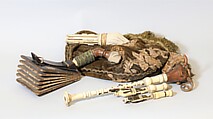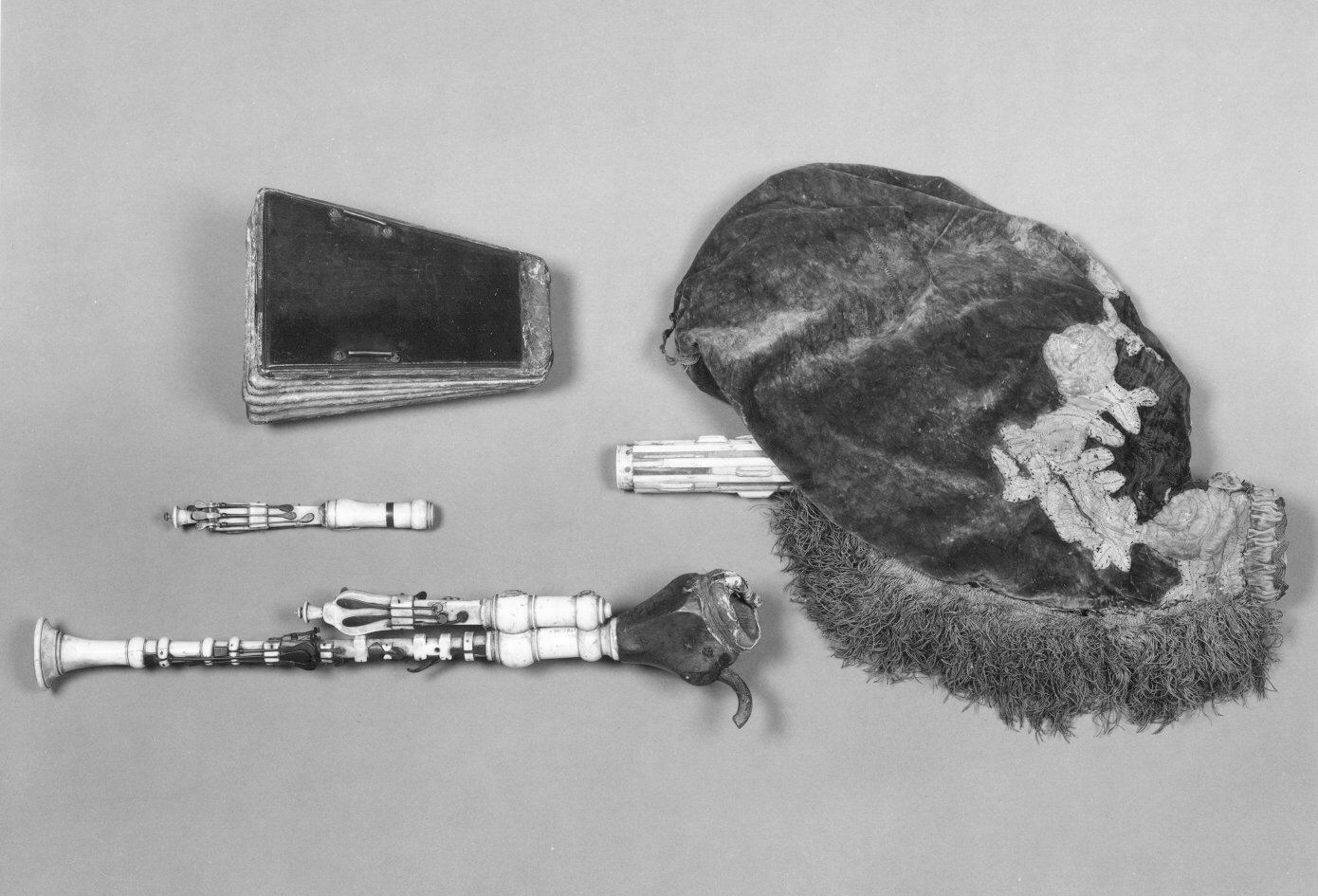Musette
Forquin French
Not on view
The musette is a type of bagpipe, usually comprising two ‘chalumeaux’ (melody pipes) and a ‘bourdon’ (drone system). Its bourdon, unique to the musette, is a single cylinder enclosing a complex pattern of parallel bores. These are internally joined to form a series of acoustic passages of differing lengths and pitches which can be tuned or silenced by the layettes (external sliders) providing a harmony to accompany the melody. Like the chalumeaux, all bores are cylindrical in cross section. Musette reeds are all double reeds both in the chalumeaux and bourdon. All the pipes are attached to a leather bag which acts an air reservoir. The musette shares this arrangement with all other bagpipes. However, the air supply for the bag is generated by a ‘soufflet’ (bellows) attached to the player’s arm. This method of inflation is not unique to the musette but is less common than the more usual inflation via a pipe held in the player’s mouth.
This instrument was developed principally in France between the later half of the 16th and the end of the 18th centuries. In contrast with the majority of bagpipes, its repertoire is entirely classical and its use is regularly specified in the pastoral scenes of operas, notably those of Lully and Rameau. There exist also, numerous works for musette published for the enjoyment of amateur players.
The present example has been extensively modified since its manufacture, yet it remains of great interest because of its unusual features, many of which are extremely rare. Most prominently, it is the only example bearing the stamp on its ‘petit chalumeau’ of Pierre Forquin (? – 1745), a musette maker active in Paris around 1740. This chalumeau has two additional keys extending the upper range higher than is possible on more usual musettes.
Furthermore, the ‘grand chalumeau’ is one of the very few known examples with an extended length. Already of a type known as ‘musette du cinq’ pitched a minor third lower than the usual musette pattern, the addition of three lower keys extends the bottom register by a further third, to permit playing in E and A. The bourdon is constructed so as to contain five individual sounding lengths offering the player the choice of two tonalities, whether in the tonic or dominant.
The alterations evident on this musette were evidently carried out with the express intention of making it playable once again. The bore of the grand chalumeau has been enlarged, some keys have been replaced and several tone holes have had their diameters modified. However, the most extraordinary transformation is that of the addition of a second petit chalumeau grafted onto the first one. This arrangement is the product of some 19th century workshop, the extra petit chalumeau being a modified 18th century item. It has been altered so as to be operated solely by the action of the right-hand thumb. The three chalumeaux are connected to the bag by means of a stock in the shape of a goat’s head, similar to that of the Bock, a bagpipe of Central Europe (see 89.4.2769). The stamp on the grand chalumeau, was identified by Herbert Heyde and probably represents the double-headed eagle, emblem of the Hapsburgs. This an important factor in understanding the remarkably complex provenance of this instrument. It is strongly reminiscent of that used by Stefan Koch (1772–1828), a Viennese instrument maker who may have been involved in the reworking of this hybrid instrument.
Thanks to a label glued on the bellows, it is known that this musette was once part of the collection of the painter, Ignatio de leon y Escosura (1834 – 1901) which was sold in New York in 1887.
(Vincent Robin and Francis Wood, 2023)
Dimensions (removed from stocks)
Grand chalumeau : L. 340 mm
Petit chalumeau 1 : L. 154 mm
Petit chalumeau 2 : L. 125 mm
Bourdon : L. 158,5 mm
Due to rights restrictions, this image cannot be enlarged, viewed at full screen, or downloaded.
This artwork is meant to be viewed from right to left. Scroll left to view more.





